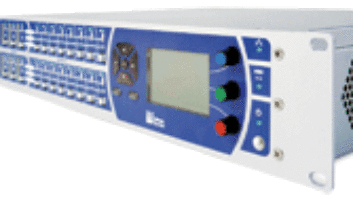
The signal path management screen offers gain/EQ/delay/
crossover/limiting/routing of the I/Os on each hardware frame.
As FOH engineer for Simon & Garfunkel, Paul Simon, Steely Dan and Bette Midler, my days are spent in arenas, stadiums and amphitheaters — acceptable, but rarely great performance areas. Recently, two developments have transformed large venues: curved line array systems, and 24-bit, WiFi-addressable multiprocessors used for crossovers, EQs, compressors and line drivers. For the past two years, my choice has been the 2-in/6-out Clair iO/Lake Technology Contour frames and the proprietary Clair/Lake software. Connected to the iO/Contour units on a WiFi-enabled PC slate, I can control the audio system from any point in the venue — something I once never dreamed possible.
STARTING OUT
When I first took out a system with the iO/Contour frames, I experienced a little “gear shock”: It takes awhile to get used to using a WiFi-capable, slate-type PC as the interface. Adjusting settings with a magnetic pencil requires timing and patience, and the computer response time is not immediate, so adapt your work rhythm to the system. Fortunately, the software’s graphics and icons for every function are easily comprehensible. Once you run the onscreen tutorial and use the system on a couple of shows, you should easily navigate from screen to screen, moving through venues and simultaneously adjusting EQs, crossovers and delays.
A single-rackspace iO/Contour frame has two modules, A and B, each with a mono input and up to three outputs. Each side can be used as a single in/out or a two- or three-way crossover; a four-way crossover requires an entire frame. The setup screens on the slate PC let you choose what capabilities are present in each module, perhaps starting with a three-way crossover. Then, give a name to each module and assign it to a software group. For example, attaching module A and module B of one frame to a stereo group would facilitate EQ’ing both sides of a system simultaneously.
MORE FRAMES, MORE POWER
Walking to any seat and hearing the part of the system I’m facing — or any other addressable speaker group in the array and its effect of any or all speaker groups — is powerful. But this requires quite a few iO/Contour frames. To generate a 270-degree coverage pattern in an average arena, I prefer two forward-facing line arrays formed with 14 i4s and two side-facing arrays, each made up of eight i4s. I normally assign an iO/Contour frame to control speaker groups no larger than four i4 cabinets each, with seven frames dedicated to the four front and side line arrays.
LF CONTROL: FROM THE TOP DOWN
I like flying line arrays as high as possible, so separating the six top units into subgroups also gives me better LF control up near the roof. In some arenas, little or no attention is given to bass trapping, and one must try to control the energy reflected from a huge, often flat roof surface. I may have the audio crew wire the P.A. so only the top two i4s are on the first iO frame instead of the top four.
Two separate iO units are dedicated to the column’s next six i4s, and the cabinets are again divided into upper (four i4s) and lower (two i4s) subgroups. The boxes in this part of the curve usually have the same vertical splay angle. I like having individual control on the bottom pair, as those boxes are often aimed at the floor seating just in front of the mix position and the bounce off the concrete can create its own set of problems. This is also the coverage area that includes the most variation in distance from the array and often requires the most massaging to sound even.
The bottom two boxes in the front array have the most vertical splay and will exhibit the least LF coupling. The floor reflection of high frequencies near the stage can be a problem for the performers, so this coverage area also receives its own dedicated iO unit.
MAKING MODULES
The power of the software is applied through the creation of control modules. A module may be as large as the entire system or as small as the smallest number of speakers each iO unit addresses. For example, I set one global module to simply mute the entire audio system including subs and frontfills. The next largest module addresses all the i4s as a group.
I set up smaller software groups to control all of the speaker subgroups — fronts and sides. The main action (crossovers/EQ/compression/delay) takes place in these groups. These modules will control one or two complete frames. I then create individual software modules to control each speaker group in the columns. These are the true working modules, and each of these has full software power: parametric/graphic EQ, crossover function, full-range delay, band delays, pre-emphasis EQ and band compression. To equalize the system, I start with graphic EQs on the speaker group level and then move to parametric on the subgroups within each larger division to make micro-adjustments.
The subwoofers have their own frame, with a module providing a lowpass filter, graphic and parametric EQ, delay, compression and level. The frontfills get a mono signal, but I use both sides of a frame to generate two two-way crossovers for inner and outer sends. The frontfills require different delay times relative to the main arrays and separate EQ relative to positioning.
In certain problem venues, another frame supplies EQ and delay for my powered near-field monitors. Including a spare, there are 11 iO frames in the drive rack, yet all of this incredible processing power still takes up far less room than carrying traditional crossovers and graphics.
David Morgan spent the past year mixing Simon & Garfunkel’s Old Friends world tour.



